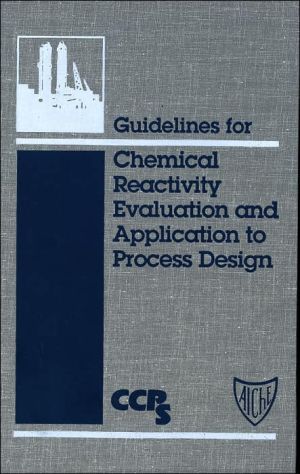

 |

|

Sold Out
Book Categories |
List of Tables.
List of Figures.
Preface.
Acknowledgments.
Glossary.
List of Symbols.
Chapter 1. Introduction.
1.1. General.
1.2. Chemical Reactivity.
1.3. Detonations, Deflagrations, and Runaways.
1.4. Assessment and Testing Strategies.
Chapter 2. Identification of Hazardous Chemical Reactivity.
2.1. Summary/Strategy.
2.1.1. Introduction.
2.1.2. Hazard Identification Strategy.
2.1.3. Exothermic Reactions.
2.1.4. Experimental Thermal and Reactivity Measurements.
2.1.5. Test Strategies.
2.1.6. Overview of Thermal Stability Test methods.
2.1.7. Examples of Interpretation and Application of Test Data.
2.2. Technical Section.
2.2.2. Identification of High Energy Substances.
2.2.3. Hazard Prediction by Thermodynamic Calculations.
2.2.3.1. Oxygen Balance.
2.2.3.2. Calculation of the Reaction Enthalpy.
2.2.3.3. Application of Computer Programs.
2.2.4. Instability/Incompatibility Factors.
2.2.4.1. Factors Influencing Stability.
2.2.4.2. Redox Systems.
2.2.4.3. Reactions with Water.
2.2.4.4. Reactions between Halogenated Hydrocarbons and Metals.
2.3. Practical Testing.
2.3.1. Screening Tests.
2.3.1.1. Thermal Analysis.
2.3.1.2. Isoperibolic Calorimetry.
2.3.2. Thermal Stability and Runaway Testing.
2.3.2.1. Isothermal Storage Tests.
2.3.2.2. Dewar Flask Testing and Adiabatic Storage Tests.
2.3.2.3. Accelerating Rate Calorimeter (ARC).
2.3.2.4. Stability Tests for Powders.
2.3.3. Explosibility Testing.
2.3.3.1.Detonation Testing.
2.3.3.2. Deflagration Testing andAutoclave Testing.
2.3.3.3. Mechanical Sensitivity Testing.
2.3.3.4. Sensitivity to heating Under Confinement.
2.3.4. Reactivity Testing.
2.3.4.1. Pyrophoric Properties.
2.3.4.2. Reactivity with Water.
2.3.4.3. Oxidizing Properties.
2.3.5. Flammability Testing.
Chapter 3. Chemical Reactivity Considerations in Process/Reactor Design and Operation.
3.1. Introduction.
3.1.1. Thermal Hazards: Identification and Analysis.
3.1.1.1. Cause, Definition, and Prevention of a Runaway.
3.1.1.2. Some Simple Rules for Inherent Safety.
3.1.1.3. Strategy for Inherent Safety in Design and Operation.
3.1.1.4. Equipment to be Used for the Analysis of Hazards.
3.2. Reactor, Heat and Mass Balance Considerations.
3.2.1. Heat and Mass Balances, Kinetics, and Reaction Stability.
3.2.1.1. Adiabatic Temperature Rise.
3.2.1.2. The Reaction.
3.2.1.3. Reaction Rate.
3.2.1.4. Reaction Rate Constant.
3.2.1.5. Concentration of Reactants.
3.2.1.6. Effect of Surrounding Temperature on Stability.
3.2.1.7. Effect of Agitation and Surface Fouling on Stability.
3.2.1.8. Mass Balance.
3.2.2. Choice of Reactor.
3.2.3. Heat Transfer.
3.2.3.1. Heat Transfer in Nonagitated Vessels.
3.2.3.2. Heat Transfer in Agitated Vessels.
3.3. Acquisition and Use of Process Design data.
3.3.1. Introduction.
3.3.2. Bench-Scale Equipment for Batch/Tank Reactors.
3.3.2.1. Reaction Calorimeter (RC1).
3.3.2.2. Contalab.
3.3.2.3. CPA ThermoMetric Instruments.
3.3.2.4. Quantitative Reaction Calorimeter.
3.3.2.5. Specialized Rectors.
3.3.2.6. Vent Size Package (VSP).
3.3.2.7. Reactive System Screening Tool (RSST).
3.3.3. Process Safety for Reactive Systems.
3.3.3.1. Test Plan.
3.3.3.2. System Under Investigation.
3.3.3.3. Test Results.
3.3.3.4. Malfunction and Process Deviation Testing.
3.3.3.5. Pressure Effect.
3.3.3.6. Results from the ARC, RSST, and VSP.
3.3.4. Scale-up and Pilot Plants.
3.3.4.1. General Remarks.
3.3.4.2. Chemical Kinetics.
3.3.4.3. Mass Transfer/Mixing.
3.3.4.4. Heat Transfer.
3.3.4.5. Self-Heating.
3.3.4.6. Scale-Up of Accelerating Rate Calorimeter (ARC) Results.
3.3.4.7. Scale-Up of Vent Size Package (VSP) Results.
3.3.5. Process Design Applications.
3.3.5.1. Batch and Semi-Batch Processing Plants.
3.3.5.2. An Example Involving Peroxides.
3.3.5.3. An Example Involving a Continuous Nitration.
3.3.5.4. A Self-Heating Example.
3.3.5.5. Batch-to-Continuous Example
3.3.5.6. Integrated Relief Evaluation.
3.3.6. Storage and Handling.
3.3.6.1. Scale-Up Example for Storage.
3.3.6.2. Peroxides.
3.3.6.3. Passive Means to Prevent Explosions.
3.3.7. Dryers and Filters.
3.4. Protective Measures.
3.4.1. Containment.
3.4.1.1. Introduction.
3.4.1.2. Determination of Gas-Vapor Release.
3.4.1.3. Laboratory Scale.
3.4.1.4. Full-Scale Example.
3.4.2. Instrumentation and Detection of Runaways.
3.4.2.1. Methods of On-Line Detection.
3.4.2.2. Methods of Noise Suppression.
3.4.3. Mitigation Measures.
3.4.3.1. Reaction Quenching Methods.
3.4.3.2. An Example Involving a Sulfonation.
3.4.3.3. Relief Disposal.
3.4.3.4. Dispersion, Flaring, Scrubbing, and Containment.
3.4.3.5. Venting.
Chapter 4. Management of Chemical Process Safety.
4.1. Hazard Identification and Quantification.
4.2. Hazard Evaluation Procedures.
4.3. Chemical Process Safety Management.
4.4. Future Trends.
References.
References Cited.
Selected Additional Readings.
Index.
Login|Complaints|Blog|Games|Digital Media|Souls|Obituary|Contact Us|FAQ
CAN'T FIND WHAT YOU'RE LOOKING FOR? CLICK HERE!!! X
 You must be logged in to add to WishlistX
 This item is in your Wish ListX
 This item is in your CollectionGuidelines for Chemical Reactivity Evaluation and Application to Process Design
X
 This Item is in Your InventoryGuidelines for Chemical Reactivity Evaluation and Application to Process Design
X
 You must be logged in to review the productsX
 X
 X

Add Guidelines for Chemical Reactivity Evaluation and Application to Process Design, Drawn from international sources, this book provides principles and strategies for the evaluation of chemical reactions, and for using this information in process design and management. A useful resource for engineers who design, start-up, operate, and ma, Guidelines for Chemical Reactivity Evaluation and Application to Process Design to the inventory that you are selling on WonderClubX
 X

Add Guidelines for Chemical Reactivity Evaluation and Application to Process Design, Drawn from international sources, this book provides principles and strategies for the evaluation of chemical reactions, and for using this information in process design and management. A useful resource for engineers who design, start-up, operate, and ma, Guidelines for Chemical Reactivity Evaluation and Application to Process Design to your collection on WonderClub |